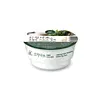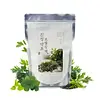What's inside
What's inside
 Key Ingredients
Key Ingredients

 Benefits
Benefits

 Concerns
Concerns

 Ingredients Side-by-side
Ingredients Side-by-side

Diatomaceous Earth
AbrasiveGlucose
HumectantTapioca Starch
Dextrin
AbsorbentCI 77231
Cosmetic ColorantAlgin
MaskingTetrapotassium Pyrophosphate
BufferingKaolin
AbrasiveHouttuynia Cordata Extract
Skin ConditioningHouttuynia Cordata Powder
Skin ConditioningArtemisia Princeps Extract
Skin ConditioningArtemisia Princeps Leaf Extract
Skin ConditioningArtemisia Capillaris Extract
Artemisia Montana Leaf Powder
ExfoliatingCamellia Sinensis Leaf
PerfumingCamellia Sinensis Leaf Powder
ExfoliatingCamellia Sinensis Leaf Extract
AntimicrobialSolanum Melongena Fruit Extract
Skin ConditioningOpuntia Coccinellifera Flower Extract
Skin ConditioningPinus Densiflora Leaf Extract
AntimicrobialCamellia Japonica Leaf Extract
Skin ConditioningPaeonia Lactiflora Extract
AstringentChlorella Vulgaris Powder
Skin ConditioningTheobroma Cacao Fruit Powder
Skin ConditioningAllantoin
Skin ConditioningBetaine
HumectantPortulaca Oleracea Extract
Skin ConditioningCentella Asiatica Extract
CleansingAloe Arborescens Leaf Powder
Skin ConditioningMagnesium Carbonate
AbsorbentCellulose Gum
Emulsion StabilisingDehydroacetic Acid
PreservativeDiatomaceous Earth, Glucose, Tapioca Starch, Dextrin, CI 77231, Algin, Tetrapotassium Pyrophosphate, Kaolin, Houttuynia Cordata Extract, Houttuynia Cordata Powder, Artemisia Princeps Extract, Artemisia Princeps Leaf Extract, Artemisia Capillaris Extract, Artemisia Montana Leaf Powder, Camellia Sinensis Leaf, Camellia Sinensis Leaf Powder, Camellia Sinensis Leaf Extract, Solanum Melongena Fruit Extract, Opuntia Coccinellifera Flower Extract, Pinus Densiflora Leaf Extract, Camellia Japonica Leaf Extract, Paeonia Lactiflora Extract, Chlorella Vulgaris Powder, Theobroma Cacao Fruit Powder, Allantoin, Betaine, Portulaca Oleracea Extract, Centella Asiatica Extract, Aloe Arborescens Leaf Powder, Magnesium Carbonate, Cellulose Gum, Dehydroacetic Acid
Diatomaceous Earth
AbrasiveGlucose
HumectantCI 77231
Cosmetic ColorantAlgin
MaskingTetrasodium Pyrophosphate
BufferingMagnesium Oxide
AbsorbentArtemisia Caruifolia Powder
AbrasiveCellulose Gum
Emulsion StabilisingChlorella Vulgaris Powder
Skin ConditioningTheobroma Cacao Fruit Powder
Skin ConditioningArtemisia Princeps Leaf Extract
Skin ConditioningHouttuynia Cordata Powder
Skin ConditioningSolanum Melongena Fruit Extract
Skin ConditioningCentella Asiatica Extract
CleansingCamellia Sinensis Leaf
PerfumingCamellia Sinensis Leaf Powder
ExfoliatingCamellia Sinensis Leaf Extract
AntimicrobialPortulaca Oleracea Extract
Skin ConditioningOpuntia Coccinellifera Flower Extract
Skin ConditioningAloe Barbadensis Leaf Juice Powder
Skin ConditioningPinus Densiflora Leaf Extract
AntimicrobialCamellia Japonica Leaf Extract
Skin ConditioningPaeonia Lactiflora Extract
AstringentGlycyrrhiza Glabra Root Powder
Skin ConditioningAllantoin
Skin ConditioningBetaine
HumectantKaolin
AbrasiveMaltodextrin
AbsorbentDehydroacetic Acid
PreservativeDiatomaceous Earth, Glucose, CI 77231, Algin, Tetrasodium Pyrophosphate, Magnesium Oxide, Artemisia Caruifolia Powder, Cellulose Gum, Chlorella Vulgaris Powder, Theobroma Cacao Fruit Powder, Artemisia Princeps Leaf Extract, Houttuynia Cordata Powder, Solanum Melongena Fruit Extract, Centella Asiatica Extract, Camellia Sinensis Leaf, Camellia Sinensis Leaf Powder, Camellia Sinensis Leaf Extract, Portulaca Oleracea Extract, Opuntia Coccinellifera Flower Extract, Aloe Barbadensis Leaf Juice Powder, Pinus Densiflora Leaf Extract, Camellia Japonica Leaf Extract, Paeonia Lactiflora Extract, Glycyrrhiza Glabra Root Powder, Allantoin, Betaine, Kaolin, Maltodextrin, Dehydroacetic Acid
 Reviews
Reviews

Ingredients Explained
These ingredients are found in both products.
Ingredients higher up in an ingredient list are typically present in a larger amount.
Algin is brown algae. Algae is an informal term for a group of aquatic organisms that can photosynthesize. It is estimated there are at least 30,000 types of Algae.
Algae contains antioxidants. Antioxidants help fight free-radicals. Free-radicals are molecules that may damage your skin cells, such as pollution.
Allantoin is a soothing ingredient known for its protective and moisturizingg properties. Because of this, it is often added to products with strong active ingredients.
Studies show higher concentrations of this ingredient can promote wound healing.
Though it can be derived from the comfrey plant, allantoin is produced synthetically for cosmetic products to ensure purity.
Learn more about AllantoinThis leaf extract comes from the Asian mugwort. It has antioxidant and anti-inflammatory properties.
Fun fact: This flower is part of the sunflower family.
Betaine is a common humectant (a substance that promotes retention of moisture). It's known to be gentle on the skin and can help balance hydration.
This ingredient is best for improving hydration and soothing irritated skin. Studies also show it helps even out skin tone.
Fun fact: Betaine is naturally created in the skin and body. The kind found within cosmetic products can be either plant-derived or synthetic.
Another name for betaine is trimethylglycine.
Learn more about BetaineCamellia Japonica Leaf Extract comes from the leaves of the Camellia japonica plant. This plant is native to East Asia.
The leaves of Camellia Japonica have been found to have anti-inflammatory compounds. These include squalene, lupeol, and vitamin E.
This extract is created by using 50% 1,3-Butylene glycol.
Learn more about Camellia Japonica Leaf ExtractCamellia Sinensis Leaf is the leaf of the tea plant. These leaves are used to make white, oolong, green, and black tea.
Tea leaves have many benefits. It contains polyphenols, a strong antioxidant. Antioxidants help fight off free-radical molecules that damage skin cells. The antioxidants in green tea neutralize free-radicals from the sun. This gives the skin some extra UV protection, but should not replace sunscreen.
Many components of tea have anti-inflammatory properties. Polyphenols and L-theanine help soothe the skin and reduce irritation. L-theanine is an amino acid that makes up most of the amino acids found in tea leaves. The caffeine in Camellia Sinensis Leaf Extract helps calm inflamed blood vessels.
Research has shown both drinking Camellia Sinensis Leaf Tea (green tea, white tea, oolong, black tea) and applying it to the skin can help boost skin elasticity and hydration. Studies also show using tea extract may reduce sebum, or oil, production.
Learn more about Camellia Sinensis LeafCamellia Sinensis Leaf Extract is derived from the leaves of the tea plant. Black tea, green tea, and oolong tea are all harvested from this plant.
This ingredient has many skin benefits:
This ingredient contains polyphenols, a strong antioxidant. Antioxidants help fight off molecules that damage skin cells.
On top of that, the antioxidants in green tea neutralize free-radicals from the sun. This gives the skin some extra UV protection, but should not replace sunscreen.
Many components of tea have anti-inflammatory properties.
Polyphenols and L-theanine help soothe the skin and reduce irritation. The caffeine in Camellia Sinensis Leaf Extract helps calm inflamed blood vessels.
Other compounds found in tea include: Vitamin Bs, linoleic acid, magnesium, calcium, iron, and zinc.
Research has shown both drinking Camellia Sinensis Leaf Tea and applying it to the skin can help boost skin elasticity and hydration. Studies also show using tea extract may reduce sebum, or oil, production.
Learn more about Camellia Sinensis Leaf ExtractCellulose Gum is a water-soluble polymer that comes from cellulose. It is used to change the texture of a product and to help stabilize emulsions.
As an emulsifier, cellulose gum specifically thicken the texture of water-based products.
This ingredient is considered hypoallergenic and non-toxic. Cellulose Gum can be found in cosmetics, food, and other household goods such as paper products.
Learn more about Cellulose GumCentella Asiatica Extract (Centella) is derived from an herb native to Southeast Asia. It is famous for its anti-inflammatory and soothing properties.
Centella is rich in antioxidants and amino acids, such as Madecassic Acid and Asiaticoside.
Studies show the compounds in centella help with:
The combination of all these properties makes centella effective at soothing, hydrating, and protecting the skin.
Other great components of centella include Vitamin A, vitamin C, several B vitamins, and Asiatic Acid.
Fun fact: Centella has been used as a medicine and in food for many centuries. As a medicine, it is used to treat burns, scratches, and wounds.
Learn more about Centella Asiatica ExtractWe don't have a description for Chlorella Vulgaris Powder yet.
We don't have a description for CI 77231 yet.
Dehydroacetic Acid is fungicide and bactericide. It is used as a preservative in cosmetics. Preservatives help elongate the shelf life of a product.
Dehydroacetic Acid is not soluble in water.
Diatomaceous Earth is an exfoliant.
Glucose is a simple sugar and is the most important source of energy in all organisms.
In skincare, glucose is used to hydrate the skin. It also acts as a prebiotic for our natural biome.
Glucose is hydrating due to its humectant property. As a humectant, glucose draws moisture from the air and from deeper levels in the skin.
Our skin contains many sugars that act as prebiotics and help strengthen our natural microbiome. Having a healthy microbiome helps protect our skin from harmful bacteria and other contaminants.
Studies show glucose may help with fading discoloration and pigmentation. This is because our skin metabolizes glucose into lactic acid. Lactic acid is an AHA that helps exfoliate the top layer of skin.
Learn more about GlucoseHouttuynia Cordata Powder comes from the Fish Mint or Chameleon plant. It is an herb native to southeast Asia and used throughout the continent. It is used in traditional cooking and medicine.
The components found in Fish Mint give it antioxidant, hydrating, antimicrobial, and anti-inflammatory properties.
Kaolin is a clay. It is used for oil control and to help minimize pores. Like other clays, kaolin has the ability to absorb excess sebum or oil. This can help clean out pores and mattify the skin.
Some types of kaolin may have exfoliating properties. When water is added to kaolin, it becomes a paste with small abrasive particles.
Most kaolin is a white color, but may be pink/orange/red depending on where it comes from.
The name 'kaolin' comes from a Chinese village named 'Gaoling'. Kaolin clay comes from rocks rich in kaolinite. Kaolinite, the mineral, has a silicate layered structure. Kaolinite is formed from chemical weathering of aluminum siilicate minerals.
Besides skincare, kaolin is commonly used to make glossy paper, in ceramics, toothpaste, and as medicine to soothe stomach issues.
Learn more about KaolinWe don't have a description for Opuntia Coccinellifera Flower Extract yet.
We don't have a description for Paeonia Lactiflora Extract yet.
Pinus Densiflora Leaf Extract is an antioxidant.
This extract comes from Purslane, a succulent. It has anti-inflammatory, antioxidant, and hydrating properties.
Purslane is very nutritious. It contains omega-3 fatty acids, NMFs, many vitamins, minerals, and antioxidants. The vitamins found in purslane include: Vitamin C, Vitamin A, and Vitamin E.
Fun fact: Purslane is a succulent with an extensive habitat. It is used in traditional Korean medicine to treat irritated skin.
Nowadays, purslane is becoming a superfood due to its highly nutritious content.
Learn more about Portulaca Oleracea ExtractWe don't have a description for Solanum Melongena Fruit Extract yet.
This ingredient is extracted from the fruit of the cocoa tree.
Each fruit contains about 20-60 seeds. Cacao seeds contain antioxidants known as polyphenols. These include flavonoids, procyanidins, and epicatechins.
The more famous ingredient from cocoa tree is cocoa butter.
Learn more about Theobroma Cacao Fruit PowderCamellia Sinensis Leaf Powder is an exfoliant.